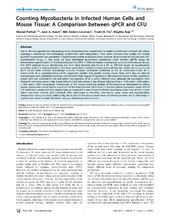| dc.description.abstract | Due to the slow growth rate and pathogenicity of mycobacteria, enumeration by traditional reference methods like colony counting is notoriously time-consuming, inconvenient and biohazardous. Thus, novel methods that rapidly and reliably quantify mycobacteria are warranted in experimental models to facilitate basic research, development of vaccines and anti-mycobacterial drugs. In this study we have developed quantitative polymerase chain reaction (qPCR) assays for simultaneous quantification of mycobacterial and host DNA in infected human macrophage cultures and in mouse tissues. The qPCR method cannot discriminate live from dead bacteria and found a 10- to 100-fold excess of mycobacterial genomes, relative to colony formation. However, good linear correlations were observed between viable colony counts and qPCR results from infected macrophage cultures (Pearson correlation coefficient [r] for M. tuberculosis = 0.82; M. a. avium = 0.95; M. a. paratuberculosis = 0.91). Regression models that predict colony counts from qPCR data in infected macrophages were validated empirically and showed a high degree of agreement with observed counts. Similar correlation results were also obtained in liver and spleen homogenates of M. a. avium infected mice, although the correlations were distinct for the early phase (<day 9 post-infection) and later phase (≥day 20 post-infection) liver r = 0.94 and r = 0.91; spleen r = 0.91 and r = 0.87, respectively. Interestingly, in the mouse model the number of live bacteria as determined by colony counts constituted a much higher proportion of the total genomic qPCR count in the early phase (geometric mean ratio of 0.37 and 0.34 in spleen and liver, respectively), as compared to later phase of infection (geometric mean ratio of 0.01 in both spleen and liver). Overall, qPCR methods offer advantages in biosafety, time-saving, assay range and reproducibility compared to colony counting. Additionally, the duplex format allows enumeration of bacteria per host cell, an advantage in experiments where variable cell death can give misleading colony counts. | en_US |

